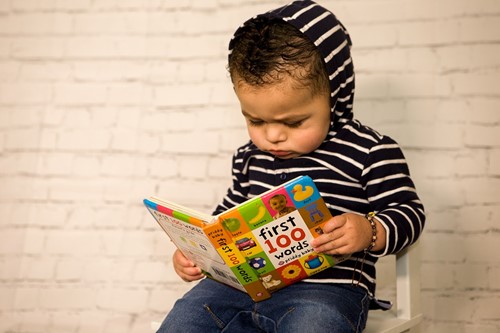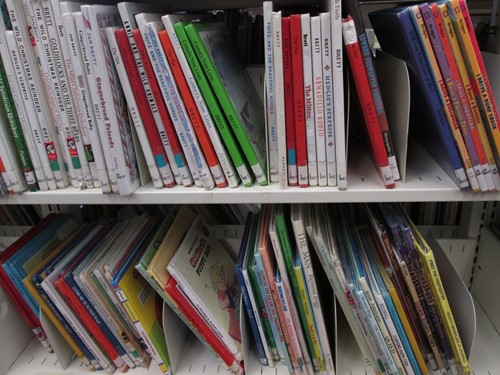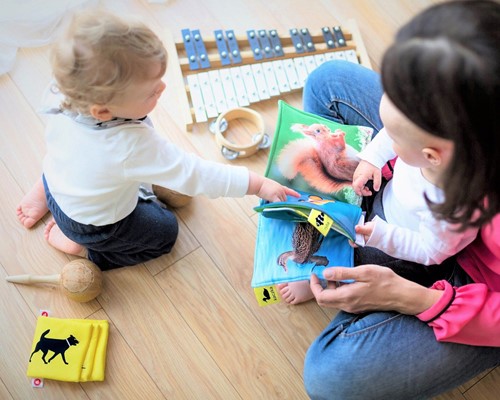Making read-aloud time part of your everyday routine—before bedtime, for example—is a great way to guarantee regular reading. Routines also help young children feel safe and secure because they know what to expect. If you have a regular reading routine, keep it up!
But if you’d like to get creative and add extra fun to what you’re already doing, we have 10 simple ideas! Whether you’re a parent, caregiver, or teacher, we hope some of these tips can work for you and the little ones you love!
1. Read to a pet. Children are delighted when you include their furry friends in read-aloud time! And if you have a child who’s learning to read, local libraries will even host events where children can read to specially trained service animals.
2. Visit your local library or bookstore for story times. It’s fun to enjoy great stories with other children and families. (And it gives you a break from reading Brown Bear, Brown Bear for the 99th time.) Local libraries offer a variety of preschool storytime programs throughout the week, often including hands-on activities, music, and opportunities for movement and play.
3. Use different voices when you read aloud. Whether you’re reading the words or simply pointing to the pictures and describing what you see, use an expressive voice to engage your child and make the book interesting. For example, you can use a high voice, a squeaky voice, a deep voice. Whisper the words or sing them. Use different voices for different characters.
4. Let your child “read” to you. If you read regularly to your toddler, you may have already discovered that they love to mimic your reading.

It’s okay that they don’t actually know how to read. Holding the book, turning the pages, making sounds—these are all important pre-reading skills! Encourage their “pretend reading” and praise them for it.
5. Find a fun place to read. Grab a handful of books and sit under a tree, build a reading fort out of cushions and blankets, or find a cozy spot under the kitchen table. Let your child experience read-aloud time as an adventure!
As your child gets a little older, the following ideas are great for helping them make connections between what they read and the world around them.
6. Visit someplace described in the book. If you’re reading a book about the farm, visit a local farm and make connections from the book, such as the animals or tractors you see.
7. Experience something from a book. Eat green eggs and ham (from Green Eggs and Ham.) Try orange marmalade on toast. (From A Bear Called Paddington.) For more ideas, check out this link: Extend Reading Experiences by Bringing Books Alive!
8. Pick silly books. Laughter is good medicine for children and adults alike! We love this list of “super silly books for kids,” many of which you’ll find at your local library.
9. Check out library books based on your child’s interests: If your preschooler is into dinosaurs, trucks, or the farm, your local library has all sorts of colorful picture books based on their interests. Children will enjoy read-alouds even more when they’re engaged in stories or information books about things they love!

10. Let them experience stories with movement and play. If you’re reading a story that takes place on a farm, for example, let them get out plastic farm animals and make the sounds each animal makes. You can also let them act out the story as you read. This is a great way for them to move their bodies, something all children need, and have an extra dose of fun with storytime.
What do all of these ideas have in common? They make read-aloud time enjoyable for both you and your child. When reading to babies and young children, there’s just one goal: give them positive experiences with books.

The Basics are 5 fun, simple and powerful ways that every parent can give every child a great start in life!
Here are some resources that can help you on your journey:
- Watch this short video for encouraging ways that real parents “Read and Discuss Stories” in everyday life. Click on the tips at the bottom of the page for Infants 0-12 months and Toddlers 12-24 months.
- Receive regular, FREE resources from The Palmetto Basics.
- Follow The Palmetto Basics on Facebook and Twitter. We provide encouraging, real-life, shareable content to help parents and caregivers!
- If you, your faith community, your organization, or your place of business would like to join us as a Champion for Children, contact us! palmettobasics@gmail.com.
Thanks for sharing this post and spreading the word about The Palmetto Basics to those within your circle of influence!

